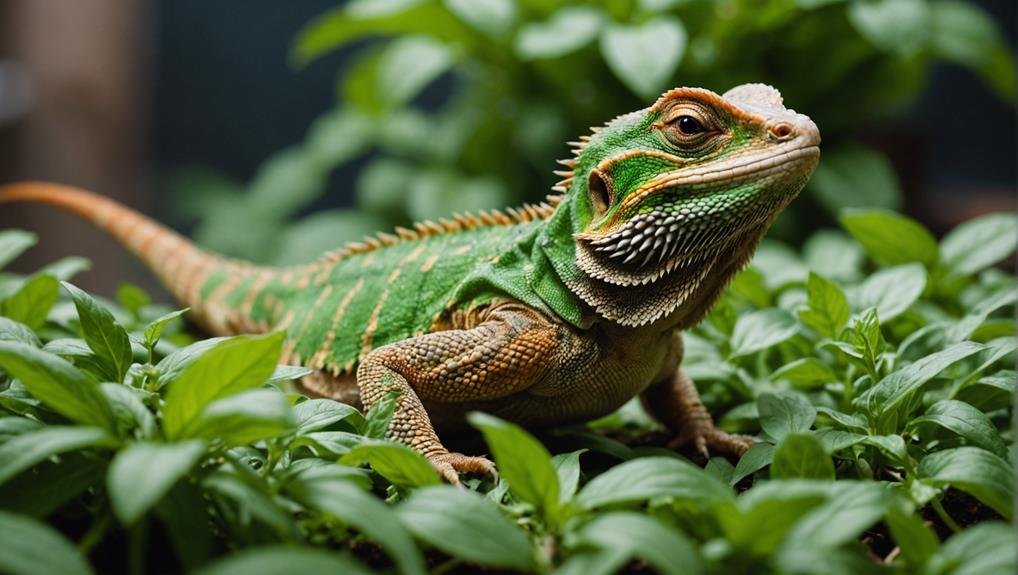You might wonder if basil is a safe and beneficial addition to your bearded dragon’s diet. Being hydrating and rich in nutrients like protein, calcium, and phosphorus, Basil can be a great supplement. However, serving it fresh, rinsed, and chopped into small pieces is important to avoid choking hazards. Now, you might question how often you should feed basil to your dragon and whether there are any potential downsides. Let’s explore the right frequency and key considerations to guarantee your bearded dragon stays healthy and happy.
Key Takeaways
- Bearded dragons can eat basil safely when served fresh and in moderation.
- Basil provides hydration, protein, calcium, and phosphorus, which are essential for bearded dragons’ health.
- Limit basil feeding to once or twice a week to avoid nutrient imbalances.
- Always rinse and chop basil into small pieces before serving to your bearded dragon.
- Monitor your dragon’s health and consult a vet to ensure a balanced diet.
Nutritional Benefits of Basil
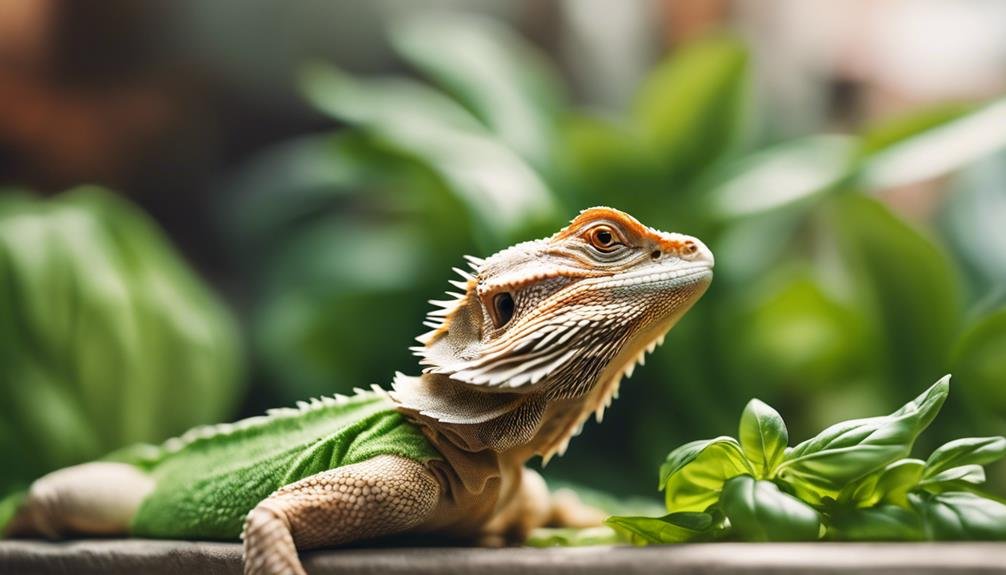

Basil offers many nutritional benefits, making it a great addition to your bearded dragon‘s diet. This herb contains essential nutrients that help keep your beardie healthy and thriving.
Basil is incredibly hydrating, containing 92 grams of water per 100 grams. This high water content guarantees that your bearded dragon stays well-hydrated, which is essential for their overall health.
Additionally, basil contributes to your beardie’s protein intake with 3 grams of protein per 100 grams. Protein is critical for the growth and maintenance of muscle tissues in bearded dragons.
Another key nutrient found in basil is calcium, which provides an impressive 177 milligrams per 100 grams. Calcium is important for bone health and prevents metabolic bone disease, which is common in bearded dragons.
Basil also offers 56 milligrams of phosphorus, which plays a role in various bodily functions, including the formation of bones and teeth. The calcium-to-phosphorus ratio in basil is ideal for bearded dragons, supporting their overall well-being.
Serving Basil to Bearded Dragons
When serving basil to your bearded dragon, thoroughly rinse the fresh leaves to remove pesticides or dirt. Clean basil leaves guarantee your pet’s safety from harmful chemicals. After rinsing, chop or tear the basil leaves into smaller pieces to make them easier for your bearded dragon to eat. Smaller pieces are not only easier to consume but also help prevent any choking hazards.
Offering basil as part of a mixed salad with other greens can enhance the variety of nutrients in your bearded dragon’s diet. Mixing basil with other greens like collard or dandelion leaves can keep mealtime interesting and nutritious. You can also sprinkle small basil flakes on their meal to entice them, as the aroma can be quite appealing.
Here’s a quick guide to serving basil to your bearded dragon:
| Step | Description |
|---|---|
| Rinse | Wash fresh basil leaves thoroughly |
| Chop or Tear | Cut into small, manageable pieces |
| Mix with Other Greens | Combine with other nutritious greens |
| Sprinkle | Add small basil flakes on top of the meal |
Fresh Vs. Dried Basil
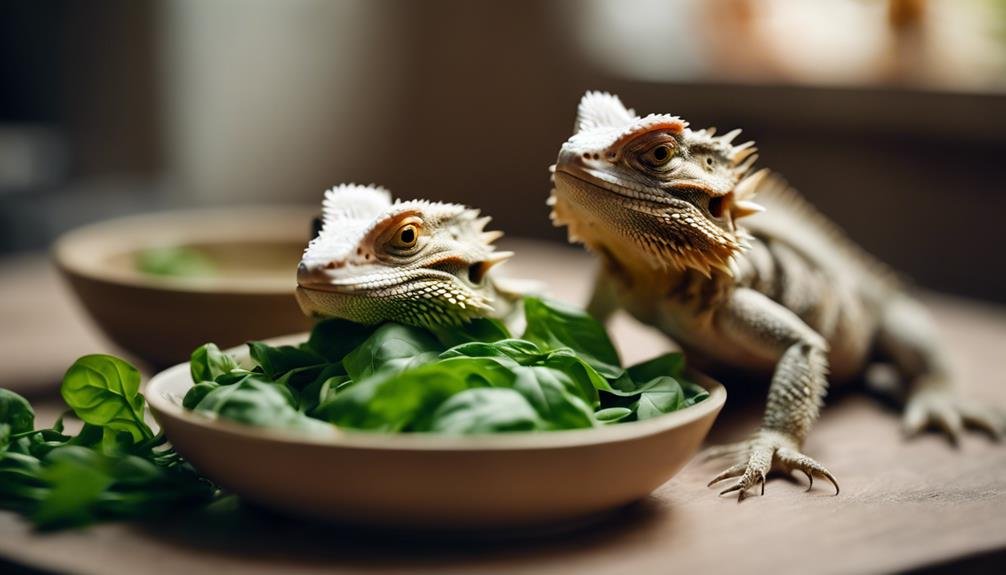

Fresh basil is generally a better choice for your bearded dragon because it’s less concentrated and palatable than dried basil. Fresh basil’s natural moisture and mild flavor make it easier for your pet to digest and enjoy.
On the other hand, dried basil has a higher concentration of essential oils and flavors, which can sometimes upset your bearded dragon’s stomach. This increased concentration can make dried basil too strong for their delicate digestive system.
When you offer fresh basil to your bearded dragon, it’s a safer and more enjoyable option. Chopping fresh basil into smaller pieces can help your pet consume it easily, reducing choking hazards. Your bearded dragon is more likely to accept and enjoy fresh basil taste than dried basil.
Dried basil not only lacks fresh basil’s appealing texture and moisture but can also be harder for your bearded dragon to chew and swallow. Dried basil’s strong, concentrated flavors may deter your pet from eating it.
To summarize, sticking with fresh basil ensures that your bearded dragon gets the benefits without any digestive discomfort.
Frequency of Basil Feeding
You should limit feeding basil to your bearded dragon once or twice a week to ensure it remains an important yet secure addition to their diet. Offering basil in moderation guarantees that your bearded dragon enjoys a varied meal without the risk of nutrient imbalances or stomach issues.
While basil can enhance your bearded dragon’s palate, it’s vital to remember that it lacks vitamin D, which is essential for its overall health.
The frequency of basil feeding should be part of a well-rounded diet, catering to their nutritional needs and preventing potential problems. Discussing your bearded dragon’s diet with a vet can help determine the ideal frequency and ensure they get all the necessary nutrients.
Here are a few ways to visualize feeding basil to your bearded dragon:
- A Small Sprinkling: Picture adding a dash of fresh basil to a mix of other greens, creating a colorful and aromatic salad.
- Weekly Treat: Imagine your bearded dragon eagerly waiting for their once-a-week basil treat, their eyes lighting up at the sight.
- Balanced Meal: Visualize a balanced plate with basil playing a small but delightful role among other nutrient-rich vegetables.
- Healthy Nails and Skin: Think of how a well-balanced diet, including occasional basil, contributes to the overall health, including your bearded dragon’s nails and skin.
Keeping the frequency of basil feeding in check is key to maintaining your bearded dragon’s health and happiness.
Basil Stems and Flowers
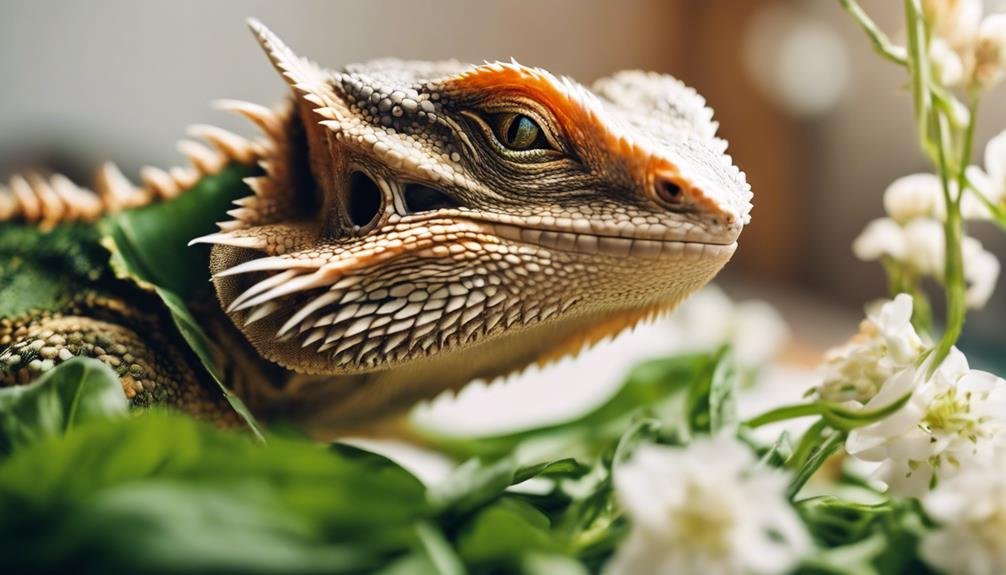

When considering basil stems and flowers, you’ll find they carry nutritional benefits similar to the leaves.
Your bearded dragon can safely consume them, but they mightn’t find the stems as tasty.
Always ensure the basil is fresh and pesticide-free to keep your pet healthy.
Nutritional Benefits Overview
Basil stems and flowers offer bearded dragons a safe and nutritious supplement to their diet. These parts of the basil plant are packed with several nutritional benefits that can positively impact your bearded dragon’s health. Although the taste mightn’t be their favorite, the stems and flowers are free from harmful compounds, making them a safe addition to their meals.
When you incorporate basil into your bearded dragon’s diet, you’ll be providing:
- Antioxidants: Basil is rich in antioxidants, which help reduce oxidative stress and boost the immune system.
- Vitamins: It contains essential vitamins like vitamins A and K, which are important for vision, growth, and blood clotting.
- Minerals: Basil contains calcium and iron, which support bone health and oxygen transport in the blood.
- Anti-inflammatory properties: Basil’s natural anti-inflammatory compounds can help reduce inflammation and promote overall well-being.
Including basil stems and flowers in your bearded dragon’s diet can be an excellent way to diversify their nutritional intake. Remember to monitor the plant placement in their enclosure to prevent trampling. By doing so, you’re ensuring they get the maximum nutritional benefits without any risks.
Safe Consumption Practices
To guarantee your bearded dragon safely consumes basil stems and flowers, gradually introducing these parts and observing their reaction is important. Start by offering some basil stems mixed with their regular greens. Monitor their behavior and appetite closely. You can slowly increase the amount if your pet shows no adverse reactions.
Some bearded dragons may not enjoy the taste despite basil stems being generally safe. Incorporate them into their diet sparingly at first. If your bearded dragon rejects the stems, don’t force the issue; they can still benefit from the leaves and flowers without any problems.
The same safe consumption practices apply to basil flowers. Introduce them gradually and watch for any changes in your pet’s behavior or digestion. Bearded dragons enjoy flowers, which can add variety to their diet.
Remember that placing basil plants in high-traffic areas of the enclosure might lead to them being trampled. Position these plants strategically to avoid damage while allowing your dragon to access and enjoy them. By following these steps, you can make sure your bearded dragon safely benefits from basil stems and flowers.
Monitoring Your Dragon’s Health
When feeding your bearded dragon basil, it’s important to monitor their weight and growth patterns to ensure their thriving.
Check their skin and shedding health regularly, as changes can indicate dietary issues.
Pay attention to their activity and behavior levels to catch any early signs of discomfort or illness.
Weight and Growth Patterns
Keeping a close watch on your bearded dragon’s weight regularly guarantees you can track growth patterns and spot any potential health issues. A healthy adult bearded dragon typically weighs bet-500 grams, with males usually larger than females.
Rapid weight changes, either gain or loss, can be a red flag indicating underlying health problems that require veterinary attention.
To help your dragon thrive, ensure a balanced diet, including occasional treats like basil, proper lighting, and the right temperature. These factors all contribute to healthy growth patterns and overall well-being. Regular weight checks help you notice deviations from the norm early, allowing for timely interventions.
Here’s what you should look for:
- Consistent weight gain: Your dragon should steadily gain weight until they reach adulthood.
- Stable adult weight: Their weight should remain relatively stable once fully grown.
- Sudden weight changes: Rapid gain or loss could indicate health issues that necessitate a vet’s attention.
- Balanced diet and environment: Proper nutrition, including the right amount of basil, and ideal living conditions support healthy growth.
Consult a reptile veterinarian if you observe significant changes in your dragon’s weight or growth patterns. Monitoring these aspects ensures your bearded dragon stays healthy and happy.
Skin and Shedding Health
Alongside monitoring weight and growth, monitoring your bearded dragon’s skin and shedding health is equally important. Regularly check their skin for signs of shedding, such as dull, flaky, or discolored patches. These indicators suggest that your dragon is about to shed or shedding.
Ensuring proper humidity levels in their enclosure is essential, as inadequate humidity can cause shedding problems and skin issues. You can support your dragon’s shedding process by offering a shedding box or giving them regular baths. The moisture helps loosen old skin, making it easier for your dragon to shed properly.
Pay attention to your dragon’s shedding patterns and look for abnormalities or complications. If shedding seems persistent or you notice unusual skin conditions, it’s best to seek veterinary advice immediately.
Proper humidity, typically around 30-40%, plays a significant role in maintaining your dragon’s skin health. An imbalance in moisture can lead to retained shed, which might result in infections or other skin complications. Monitoring and keeping these aspects will ensure your bearded dragon stays healthy and comfortable.
Activity and Behavior Levels
Monitoring your bearded dragon’s activity and behavior levels is crucial for evaluating their health and well-being. Changes in activity levels, such as reduced movement or lethargy, can indicate potential health issues that need your attention. Regularly observing your dragon helps you track unusual patterns or signs of illness, enabling timely intervention if required.
Bearded dragons are naturally curious and active creatures. Encourage their physical activity and mental stimulation by providing a variety of climbing structures, hideouts, and safe spaces to explore. A healthy diet, including occasional treats like basil, can support their energy and vitality.
Here are some key points to help you monitor your dragon’s activity and behavior:
- Watch for changes: Sudden drops in activity levels or unusual lethargy can signal something’s wrong.
- Encourage movement: Create an engaging environment with climbing branches and interactive toys.
- Observe eating habits: A sudden disinterest in food, including basil, may indicate health issues.
- Seek professional advice: Consult a reptile veterinarian if you notice significant changes in behavior.
Safe Herbs for Bearded Dragons
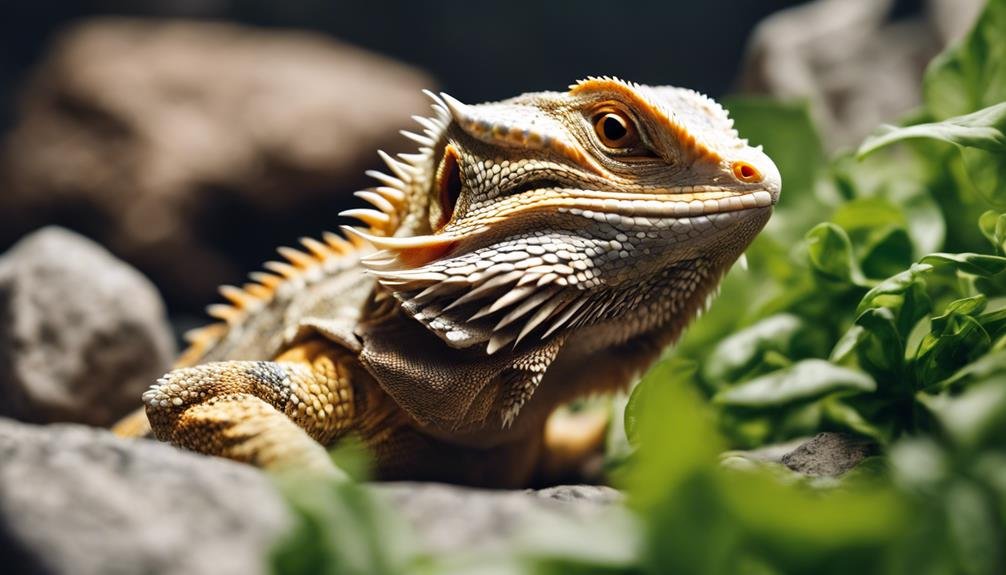

When you want to diversify your bearded dragon’s diet, safe herbs like basil can be a nutritious and tasty addition. Basil isn’t only secure and packed with vitamins A, C, E, and K, antioxidants, and anti-inflammatory properties, making it a great choice for your beardie.
In addition to basil, other safe herbs you can offer include chicory, cilantro, fennel, and lemongrass. Each of these herbs provides unique nutritional benefits that can contribute to your bearded dragon’s overall health. For instance, chicory is fiber-rich, aiding digestion, while cilantro offers essential minerals like calcium and potassium.
It’s important to use fresh herbs over dried ones to prevent stomach upset and ensure your bearded dragon finds them palatable. Rosemary is another excellent herb choice due to its high calcium content and fiber, which supports digestion.
Conclusion
Incorporating basil into your bearded dragon’s diet can be a healthy choice if you do it in moderation. Fresh, rinsed, and chopped basil provides essential nutrients and hydration.
Feed your Dragonlance twice a week to prevent nutrient imbalances. Always monitor your dragon’s health, weight, and behavior to ensure it’s thriving.
Remember, a varied diet with safe herbs will keep your bearded dragon happy and healthy.

